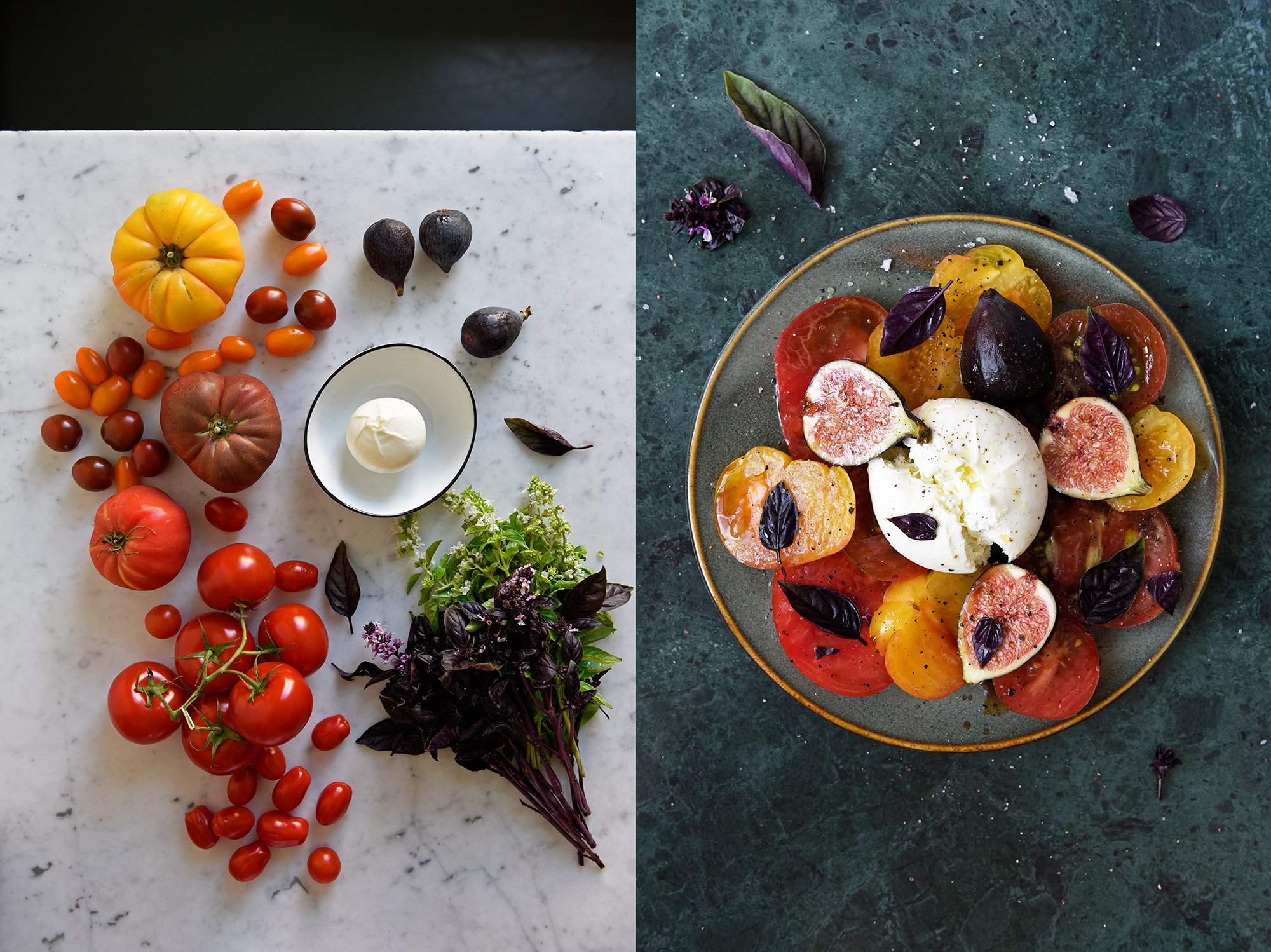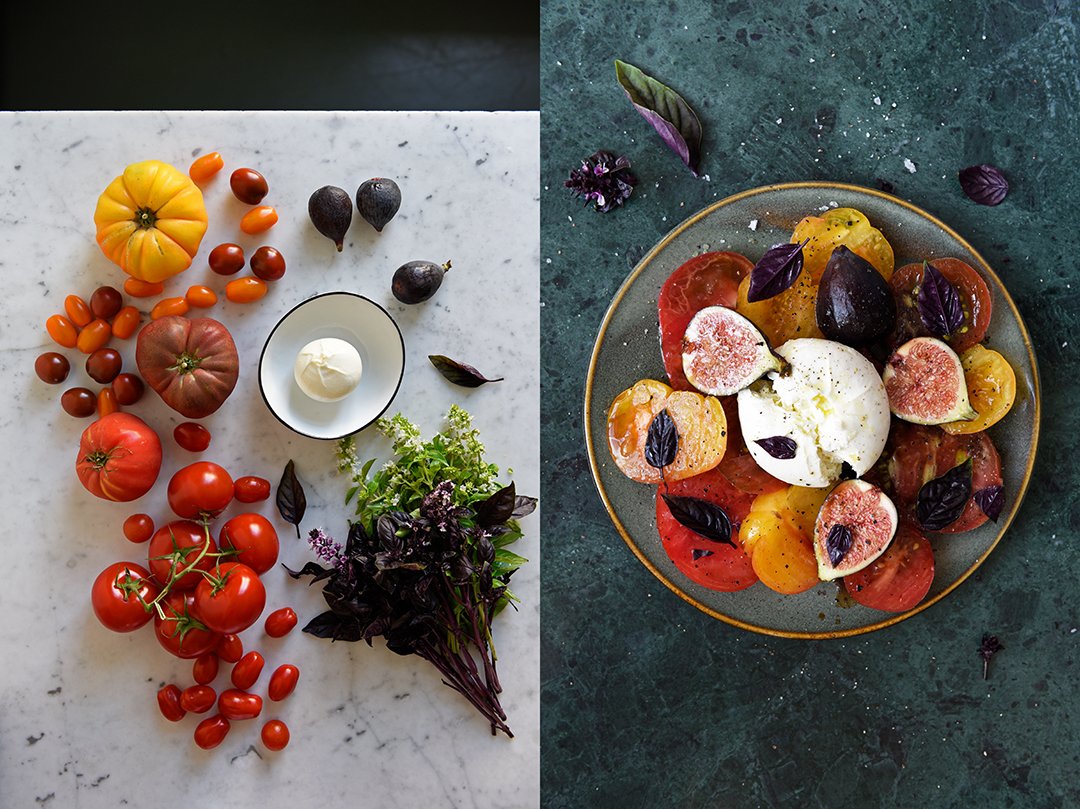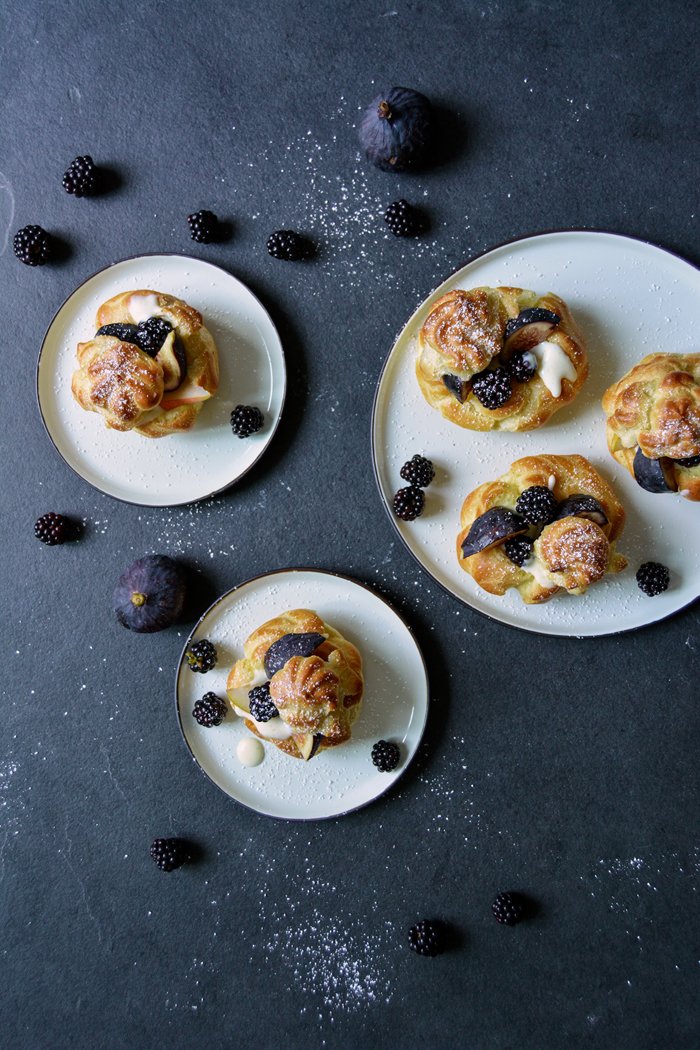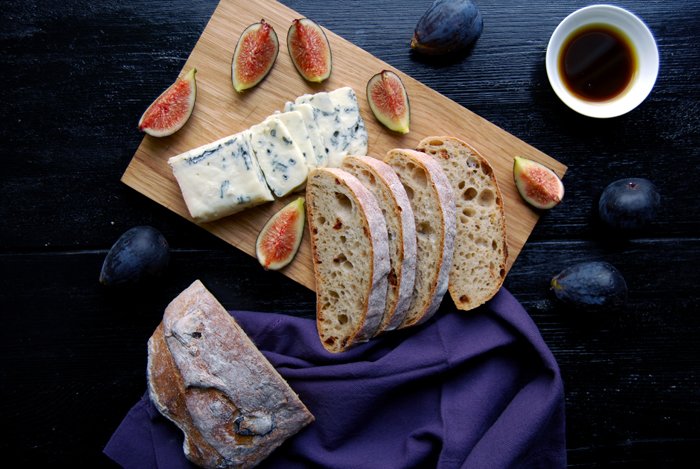Tomato and Fig Caprese & the NOON Book Tour
No other season inspires me as much as late summer. The mesmerizing abundance of vegetables and fruit in August and September never ceases to wake up my appetite and makes me want to experiment with it in my kitchen. Seeing the colorful fresh produce spread out at the stalls at the weekly farmers market in my neighborhood feels like a holiday for the eyes and the taste buds. Tomatoes in various shapes, colors, and sizes, yellow and green zucchini, bent and plump, apricots, peaches, and figs, and little berries that burst in your mouth when you pop their skins with your teeth. Red and black currants, gooseberries, and raspberries, pair them with a bunch of fresh herbs and a quick vinaigrette and you have an exciting salad ready for lunch in less than five minutes.
The classic caprese, loved and adored every summer all over the world, is kind of the mother of all simple salads. You just need juicy tomatoes, creamy burrata (or stracciatella), torn basil leaves, olive oil, balsamic vinegar, sea salt, and pepper. Replacing the usual mozzarella with burrata or stracciatella, using olive oil that’s so good that you want to lick it off your fingers, and my sea salt from Gozo, are game changers in a simple caprese. One of the most important kitchen rules is so true: the less ingredients you use, the more you have to focus on the quality of each single one of them.
A good caprese is built on ripe tomatoes, picked at their peak, and that’s the tricky part. Even in August, even the prettiest tomatoes from your trusted farmer at the market can sometimes disappoint. And if they taste bland, they won’t make your dish shine either. To avoid this, I’ve come up with various experimental caprese recipes over the years, moving away from tradition and using all sorts of fruits and roots throughout the seasons; summer’s bounty of peaches, berries, and plums, or beet, persimmon, and orange in winter.
Until now, I always refused to pair tomato with another fruit, the combinations never really satisfied me. So at first, I was hesitant when I spotted purple figs lying on my kitchen counter and considered adding them to a classic caprese. But: the result was fantastic! The figs add concentrated sweetness without distracting from the tomato’s own qualities. They just make them taste a bit sweeter, somehow, they make them taste like very ripe summer tomatoes.
It’s a kitchen hack, kind of, that I wish I had figured out before I wrote my new book, NOON. Now the book is printed so I guess I have to use this hack for the next one. But before I jump into new adventures again, I’m ready to fully enjoy seeing NOON enter the world. On September 5th (September 19th for the German book), NOON will be on the shelves of bookstores all over the world (and on sale online) - and I will go on a little NOON book tour: New York, Berlin, and London!
Before I’ll let you enjoy your tomato and fig caprese (recipe below), I’m sharing the tour dates with you and the wonderful people who I’ll be in conversations with - and a quote from an (early) starred review for NOON:
“Move over, breakfast: lunch is about to become the most important meal of the day.”
―Library Journal
If you don’t want to wait until September, you can pre-order NOON here, or support local and pre-order from your neighborhood bookstore.
NOON BOOK TOUR
NEW YORK
• September 7th, 2023, 6pm: at Rizzoli Bookstore, with Hetty Lui McKinnon, RSVP here (not required, but seating is limited and will be first come, first served)
BERLIN
• September 19th, 2023: in conversation with Billy Wagner of Nobelhart & Schmutzig (by invitation only)
LONDON
• October 5th, 2023, 7pm: at Building Feasts, with Helen Goh, hosted by Hanna Geller, ticketed event (to book a ticket, click here or email Hanna at info@buildingfeasts.com)
Thank you, Lallier Champagne, for sponsoring the NOON Book Tour!
Tomato and Fig Caprese
Serves 1
3 medium, very ripe tomatoes (preferably in various colors), sliced
2 figs, cut in half lengthwise
4 ounces / 110g burratta (or stracciatella or mozzarella di bufala)
olive oil
balsamic vinegar
flaky sea salt
ground pepper
a small handful of red or green basil leaves
Spread the tomatoes on a large plate and arrange the figs and burrata on top. Drizzle with a little olive oil and vinegar, season with a little salt and pepper, and sprinkle with basil. Enjoy immediataley!
Italian Meringue with Honey Mascarpone and Figs
Most of the beaches and bays, restaurants and cafés, and markets and shops I visit in Malta are treasured finds of the past. Since I spent my first summer here 9 years ago, I gathered a long list of many places that I need to see at least once every time I come to the islands - I barely have enough time to discover something new. There are many traditions that I set up for myself, like my annual visit to the Sunday morning mass at Valletta's St John's Co-Cathedral, which is held in Latin and accompanied by the most ethereal choir. I went to this magnificent cathedral with my Maltese mama, the rest of the house was still asleep, and afterwards we enjoyed a strong cappuccino at Caffe Cordina. I recommend sitting inside with the locals, next to the bar and order some of their addictive treats. This time I went for spongy rum baba deeply soaked with sticky syrup followed by a buttery ricotta pastizzi - both were divine.
Fontanella Tea Garden in Mdina is another one of my favourite sweet spots. The view is breathtaking, sitting high up on a hill surrounded by ancient bastions, it allows you to see large parts of the island. Their chocolate cake is a classic, dark and juicy and a must whenever I visit Malta's old capital.
But all these sweets are still not enough of a reason to keep the oven back home in Msida switched off. The antique furniture, plates, and cutlery that fill our family's Malta home inspired me to come up with a dessert that suits all the beautiful lace doileys, fragile tea cups and silver tablets with floral patterns. An elegant meringue, lusciously topped with whipped honey mascarpone and Maltese figs was just right - visually and in taste. It's sweet and creamy, light and crunchy, with a juicy hint of fruit. Italian meringues are large and pale, crunchy on the outside and still a little soft inside. I preheated the oven to 160°C / 325°F, turned it off, and left the meringue in overnight, they came out perfect. The mascarpone whipped with a bit of heavy cream and warm honey was a nice contrast to the meringue's crunch.
Italian Meringue with Honey Mascarpone and Figs
For the meringue
large organic egg whites 3
a pinch of salt
granulated sugar 200g / 1 cup
cider vinegar 1/2 teaspoon
For the honey mascarpone
mascarpone, drained, 250g / 9 ounces
heavy cream 2 tablespoons
aromatic honey, like thyme or orange blossom, 2-3 tablespoons
For the topping
ripe figs, quartered, 6
It's best to prepare the meringues a day ahead and leave them in the oven overnight.
Preheat the oven to 160°C / 325°F (conventional setting) and line a baking sheet with parchment paper.
For the meringue, in a large bowl of a stand mixer, whisk the egg whites and salt for 1 minute. Continue whisking for 15 minutes, adding 1 tablespoon of the sugar at a time. The meringue should be stiff and glossy, then whisk in the vinegar. Spoon 6 large mounds onto the lined baking sheet and, using a spoon, swirl the tops a little. Place the baking sheet in the oven, switch off the oven, and bake the meringues overnight (for about 8 - 12 hours), without opening the door. If the meringues are still too soft on the outside, turn on the oven again and bake for a few minutes until crunchy on the outside.
For the honey mascarpone, in a medium bowl whisk the mascarpone and heavy cream until creamy, add more cream if necessary. Warm up the honey in a saucepan over low heat for about 1 minute until liquid and slightly warm, and stir into the mascarpone. Keep in the fridge until serving.
Cut a small top off each meringue, top with the honey mascarpone and figs, and close with the meringue tops. Serve immediately once the meringues are filled.
Sunday Profiteroles! Vanilla Cream Puffs with Figs, Pears and Blackberries
There's something wonderfully old-fashioned about profiteroles - or cream puffs. And they look so voluptuous. Generously filled with vanilla cream, ripe figs, pears, and blackberries they are anything but a simple teatime sweet. This creation calls for a pretty coffee table, delicate porcelain, frilly napkins, and table cloth, my granny Annie would have loved it! She was very much into extravagant Sunday afternoon treats, she used to welcome her guests all dressed up, with lipstick and jewelery. Her Frankfurt Crown Cake - the German Frankfurter Kranz - is a legendary masterpiece, delicious and opulent, it was the star of many coffee tables in my childhood.
Airy choux pastry, golden and crisp, is the secret of a good profiterole. Be it in an elegant oblong éclair or a baroque shaped Windbeutel (meaning cream puff in German), the pastry needs to rise like a ballon but then keep its shape and not deflate. To get there stress-free, there are two rules to obey: the door of the oven should never be opened while the pastry is baking; and, once it's done, the little puff balls have to stay in the oven with the door closed for a few minutes to dry and build up structure. After they cooled off a little they are more robust than they may seem, which is helpful as they have to carry quite a rich filling.
Vanilla Cream Puffs with Figs, Pears and Blackberries
For 12 cream puffs you need
For the vanilla cream
milk 350ml / 1 1/2 cups
large egg yolks 2
granulated sugar 80g / 1/3 cup and 1 tablespoon
a pinch of salt
cornstarch 30g / 1/4 cup
vanilla pod, slit, 1
heavy cream, whipped, 100ml / 1/3 cup and 2 tablespoons
For the choux pastry
butter 80g / 3 ounces
granulated sugar 4 teaspoons
a pinch of salt
milk 90ml / 1 /3 cup and 1 tablespoon
water 90ml 1 /3 cup and 1 tablespoon
all-purpose flour, sieved, 130g / 1 cup
large eggs 3
For the fruit filling
crisp pear, cut into slim wedges, 1
ripe figs, cut into slim wedges, 6
blackberries, a small handful
icing sugar, for the topping (optional)
For the vanilla cream, whisk 4 tablespoons of the milk with the egg yolks, sugar, salt and cornstarch until well combined. In a saucepan, bring the remaining milk with the vanilla pod to the boil. Take the vanilla pod out and scrape the seeds out of the bean into the milk. Add the egg-sugar mixture to the hot milk, whisking well. Take the saucepan off the heat immediately and whisk for another minute. If it crumbles, whisk in a little more milk. Let the cream cool and then chill in the fridge for at least 30 minutes. Once it's cool, whip the heavy cream and fold into the vanilla cream gently. Keep the vanilla cream in the fridge until you fill the choux pastry.
Set the oven to 200°C ( 400°F) (top / bottom heat) and line a baking sheet with baking paper.
For the dough, bring the butter, sugar, salt, milk and water gently to the boil. When the butter has melted, stir in the flour vigorously with a wooden spoon, mix until smooth and the dough comes away from the side of the pan. Transfer the dough to a bowl and let it cool for about 10 minutes. Beat the eggs in with a spoon, one at a time, only mix in the next one when the one before is well combined.
Fill the dough in a piping bag with a wide nozzle and pipe the mixture into 12 balls. Bake in the oven for about 19 minutes or until golden brown and crisp, don't open the door while the choux pastry is baking. When it's done, switch off the oven but leave it closed. After 5 minutes open the door slightly, only the stick of a wooden spoon should fit in, and let the pastry dry for another 5 minutes (this way they keep their shape). Take them out of the oven and let them cool on a wire rack completely.
Prepare the cream puffs just before serving: cut off the tip, fill generously with vanilla cream and fruits and close with the lid again. Sprinkle with icing sugar (optional) and enjoy!
Fig and Gorgonzola Ciabatta Sandwich
Late summer figs call for a late summer sandwich, an effortless combination of honey sweet fruit and creamy blue cheese. There's no cooker involved in the preparations, no oven or grill, just 5 ingredients put together in less than 5 minutes and a glass of red wine to go with. This is an early evening sandwich, when you sit outside on your balcony or in the garden, some cheese and prosciutto on the table, a quick salad of rucola thrown together with the last ripe tomatoes from the vine and a light vinaigrette. All you need are some candles, a friend to talk, some music maybe, a glass of dark red wine and this marvelous duo of figs and Gorgonzola.
Figs are one of those fruits that I could eat all year round but, unfortunately, the pleasure of their sweetness, taste and delicateness is limited to only a few summer months. In Malta I pick them off the trees but here, in the city, they are quite a luxurious treat and the quality barely justifies the price. They are never as ripe, soft and tasty as in the Mediterranean, it would be impossible to transport them. So when I spotted a box of organic Italian figs at the market, soft and thin skinned, nothing could stop me. I bought a big handful of them, enough to make a dozen of these late summer sandwiches!
For 6 open tartines, you need a loaf of fresh ciabatta bread, the slices lightly brushed with a dressing of 2 teaspoons of olive oil and 1 teaspoon of Balsamico vinegar which makes the bread soft and juicy. I cut 130g (4.5 ounces) of Gorgonzola into slices and quartered 6 ripe Mediterranean figs. Their skin was was so thin that I didn't even need to peel them, I rinsed them off and spread them with the cheese on the bread and sprinkled the remaining dressing over them.






























